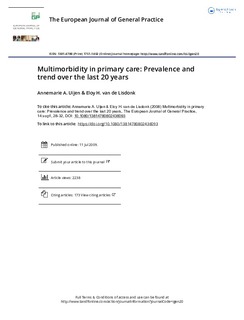Multimorbidity in primary care: Prevalence and trend over the last 20 years
Original version
Uijen, A. A. & Van de Lisdonk, E. H. (2008). Multimorbidity in primary care: Prevalence and trend over the last 20 years. European Journal of General Practice, 14(S1), 28-32. https://doi.org/10.1080/13814780802436093Abstract
Objective: To determine the prevalence of multimorbidity in primary care, by age, sex, and socio-economic class, and to analyse the trend in multimorbidity over the last 20 years.
Methods: We performed an observational study using data from the Continuous Morbidity Registration (CMR) Nijmegen. This registration includes approximately 13 500 enlisted patients. To study the distribution of multimorbidity by age, sex, and socio-economic class, we analysed all patients enlisted in the CMR in 2005. To analyse the trend of multimorbidity over time, we studied the prevalence of multimorbidity from 1985 to 2005.
Results: We found that increasing age, female sex, and low socio-economic class are associated with an increasing number of patients with multimorbidity. The prevalence of chronic diseases doubled between 1985 and 2005. The proportion of patients with four or more chronic diseases increased in this period by approximately 300%.
Conclusion: The increasing amount of multimorbidity in primary care as well as the increasing number of chronic diseases per patient leads to more complex medical care. The general practitioner needs guidelines focusing on multimorbidity to support this care. The registration of chronic diseases by the general practitioner will become more complex and time-consuming.
